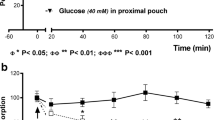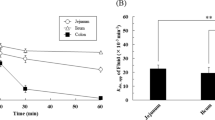Abstract
We studied the effect of ethanol on glucose and water absorptionin vivo. In preliminary experiments, using sodium amytal anesthesia, we found that control animals, whose jejunal segment was perfused without ethanol, required more anesthetic agent than those perfused with ethanol. Thus, to allow for unbiased comparison of the absorption data between the two groups of animals, all absorption studies were carried out on conscious restrained hamsters. We found that ethanol did not influence the permeability of the jejunum to polyethylene glycol (PEG) and meglumine diatrizoate. In addition, ethanol did not influence the time required for the onset of steady-state absorption. Using both the gravimetric and the electrical methods, we were unable to show any measurable osmotic pressure exerted by ethanol (150–1050 mM) on the hamster jejunum. In the absorption studies we found that perfusion of the hamster jejunum with five increasing concentrations of ethanol (450–1050 mM) appeared to cause a concentration-dependent depression in steady-state glucose transport. Water transport was depressed only when 4.8% (1050 mM) ethanol was perfused.
Similar content being viewed by others
References
Chang T, Lewis J, Glazko AJ: Effect of ethanol and other alcohols on the transport of amino acids and glucose by everted sacs of rat small intestine. Biochim Biophys Acta 135:1000–1007, 1967
Dinda PK, Beck IT, Beck M, McElligott TF: Effect of ethanol on sodium-dependent glucose transport in the small intestine of the hamster. Gastroenterology 68:1517–1526, 1975
Dinda PK, Beck IT: On the mechanism of the inhibitory effect of ethanol on intestinal glucose and water absorption. Am J Dig Dis 22:529–533, 1977
Fromm D, Robertson R: Effects of alcohol on ion transport by isolated gastric and esophageal mucosa. Gastroenterology 70:220–225, 1976
Cawley LP, Spear FE, Kendall R: Ultramicro chemical analysis of blood glucose with glucose oxidase. Am J Pathol 32:195–200, 1959
Snedecor GW, Cochran WG: Statistical Methods, 6th ed. Ames, Iowa, Iowa State University Press, 1967
Detheridge JF, Matthews J, Smyth DH: The effect of inhibitors on intestinal transfer of glucose and fluid. J Physiol (London) 183:369–377, 1966
Pirola RC, Davis AE: Effects of intravenous alcohol on motility of the duodenum and of the sphincter of Oddi. Aust Ann Med 1:24–29, 1970
Robles EA, Mezey E, Halsted CH, Schuster MM: Effect of ethanol on motility of the small intestine. Johns Hopkins Med J 135:17–24, 1974
Beck IT, Dinda PK: On the mechanism of isoosmotic transport of fluid across the small intestine. The effect of the Staverman reflection coefficient of the solute used to increase the osmolality of the mucosal solution on the composition of the absorbate. Can J Physiol Pharmacol 52:96–104, 1974
Lindemann B, Solomon AK: Permeability of luminal surface of intestinal mucosal cells. J Gen Physiol 45:801–810, 1962
Wright EM, Diamond JM: An electrical method of measuring nonelectrolyte permeability. Proc R Soc Ser B 172:203–225, 1969
Saunders DR, Sillery J, Rachmilewitz D: Effect of dioctyl sodium sulfosuccinate on structure and function of rodent and human intestine. Gastroenterology 69:380–386, 1975
Krawitt EL: Ethanol inhibits intestinal calcium transport in rats. Nature 243:88–89, 1973
Baraona E, Pirola RC, Lieber CS: Small intestinal damage and changes in cell population produced by ethanol ingestion in the rat. Gastroenterology 66:226–234, 1974
Israel Y, Valenzuela JE, Salazar I, Ugarte G: Alcohol and amino acid transport in the human small intestine. J Nutr 98:222–224, 1969
Halsted CH, Robles EA, Mezey E: Distribution of ethanol in the human gastrointestinal tract. Am J Clin Nutr 26:831–834, 1973
Israel Y, Salazar I, Rosenmann E: Inhibitory effects of alcohol on intestinal amino acid transportin vivo andin vitro. J Nutr 96:499–504, 1968
Baraona E, Lieber CS: Intestinal lymph formation and fat absorption: Stimulation by acute ethanol administration and inhibition by chronic ethanol feeding. Gastroenterology 68:495–502, 1975
Houston JB, Levy G: Effect of various alcohols on intestinal net water flux and theophylline absorption in rats. J Pharm Sci 64:607–610, 1975
Broitman SA, Gottlieb LS, Vitale JJ: Augmentation of ethanol absorption by mono and disaccharides. Gastroenterology 70:1101–1107, 1976
Seeman P: The membrane actions of anaesthetics and transquilizers. Pharm Rev 24:583–655, 1972
Dinda PK, Beck IT: The effect of local anaesthetics on the transmural potential difference of the small intestine of the rat. Can J Physiol Pharmacol 47:445–451, 1969
Miller DL, Schedl HP: Total recovery studies of non-absorbable indicators in the rat small intestine. Gastroenterology 58:40–46, 1970
Barreiro MA, McKenna RD, Beck IT: Determination of transit time in the human jejunum by the single injection indicator-dilution technic. Am J Dig Dis 13:222–233, 1968
Barreiro MA, McKenna RD, Beck IT: The physiologic significance of intraluminal pressure changes in relation to propulsion and absorption in the human jejunum. Am J Dig Dis 13:234–251, 1968
Levine RR, McNary WF, Kornguth PJ, LeBlanc R: Histological reevaluation of everted gut technique for studying intestinal absorption. Eur J Pharmacol 9:211–219, 1970
Robinson AG, Loeb JN: Ethanol ingestion—commonest cause of elevated plasma osmolality? N Engl J Med 284: 1253–1255, 1971
Pickett WJ, Hirschowitz BI: Measurement of plasma osmolaity. N Engl J Med 285:354–355, 1971
Read RC: Ethanol and measurement of plasma osmolality. N Engl J Med 285:636, 1971
Medart WS, Jr: Ethanol, osmolality and rational chemical units. N Engl J Med 285:1266, 1971
Champion HR, Capla YH, Baker SP, Long WB, Benner C, Crowley AR, Fisher R, Gill W: Alcohol intoxication and serum osmolality. Lancet 1:1402–1404, 1975
Vyrodov IP, Bud'ko PS, Derkach LV: Use of kinetic concepts of the structure of a liquid to determine molecular dimensions. Russ J Physiol Chem 38:126–129, 1964 (Eng. trans.)
Wright EM, Diamond JM: Patterns of non-electrolyte permeability. Proc R Soc Ser B 172:227–271, 1969
Fox JE, McElligott TF, Beck IT: The effect of ethanol on the morphology of the hamster jejunum. Am J Dig Dis (in press)
Author information
Authors and Affiliations
Additional information
Supported by MRC Grant No. MA.4257.
This work is included in the PhD thesis of J.E. Fox and formed a part of the material for the 1977 Student Research Prize of the Canadian Foundation for Ileitis and Colitis awarded to J.E. Fox.
Rights and permissions
About this article
Cite this article
Fox, J.E., Bourdages, R. & Beck, I.T. Effect of ethanol on glucose and water absorption in hamster jejunumin vivo methodological problems: Anesthesia, nonabsorbable markers, and osmotic effect. Digest Dis Sci 23, 193–200 (1978). https://doi.org/10.1007/BF01072317
Issue Date:
DOI: https://doi.org/10.1007/BF01072317




